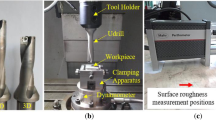Abstract
The present study highlights the Taguchi design of experiment techniques proved to be an efficient tool for the design of neural networks’ surface roughness to predict in the grinding process, where CNT mixed nanofluids are used as dielectric for machining AISI D3 Tool steel material. Empirical model for the prediction of output parameters has been developed using regression analysis and the results are compared for with and without using CNT nanofluids. Analysis of variance and F test is used to determine the significant parameter affecting the surface roughness which is the crucial parameter for any grinding process. Feedforward artificial neural networks are used to train the experimental values with the Levenberg–Marquardt algorithm; the most influencing factors are determined. The predicted surface roughness for without using CNT based cutting fluid is 11.3 % and with CNT is 10.37 %. Further, a fuzzy logic system is used to investigate the relationship between the machining process parameters’ accuracy and to determining the efficiency of each parameter design with Taguchi design of experiments.













Similar content being viewed by others
Explore related subjects
Discover the latest articles and news from researchers in related subjects, suggested using machine learning.References
Saidur R, Leong KY, Mohammad HA (2011) A review on applications and challenges of nanofluids. Renew Sustain Energy Rev 15:1646–1668
Venkatesan D, Kannan K, Saravanan R (2009) A genetic algorithm-based artificial neural network model for the optimization of machining processes. Neural Comput Appl 18:135–140
Mamalis AG, Vogtlander LOG, Markopoulos A (2004) Nanotechnology and nanostructured materials: trends in carbon nanotubes. Precis Eng 28:16–30
Xie H, Lee H, Youn W, Choi M (2003) Nanofluids containing multiwalled carbon nanotubes and their enhanced thermal properties. J Appl Phys 94(8):4967–4971
Prabhu S, Vinayagam BK (2012) AFM investigation in grinding process with nanofluids using Taguchi analysis. Int J Adv Manuf Technol 60:149–160
Lin Y-C, Chen Y-F, Wang D-A, Lee H-S (2009) Optimization of machining parameters in magnetic force assisted EDM based on Taguchi method. J Mater Process Technol 209:3374–3383
Chattopadhyay KD, Verma S, Satsangi PS, Sharma PC (2009) Development of empirical model for different process parameters during rotary electrical discharge machining of copper–steel (EN-8) system. J Mater Process Technol 209:1454–1465
Caydas U, Hascalık A (2008) A study on surface roughness in abrasive water jet machining process using artificial neural networks and regression analysis method. J Mater Process Technol 202:574–582
Benardos PG, Vosniakos GC (2002) Prediction of surface roughness in CNC face milling using neural networks and Taguchi’s design of experiments. Robot Comput Integr Manuf 18:343–354
Altan M (2010) Reducing shrinkage in injection moldings via the Taguchi, ANOVA and neural network methods. Mater Design 31:599–604
Korkut I, Acır A, Boy M (2011) Application of regression and artificial neural network analysis in modeling of tool–chip interface temperature in machining. Expert Syst Appl 38:11651–11656
Khaw JFC, Lim BS, Lim LEN (1995) Optimal design of neural networks using the Taguchi method. Neurocomputing 7:225–245
Yilmaz O, Eyercioglu O, Gindy NNZ (2006) A user-friendly fuzzy based system for the selection of electro discharge machining process parameters. J Mater Process Technol 172:363–371
Tzeng Y-f, Chen F-c (2007) Multi-objective optimisation of high-speed electrical discharge machining process using a Taguchi fuzzy-based approach. Mater Design 28:1159–1168
Hashmi K, El Baradie MA, Ryan M (1999) Fuzzy-logic based intelligent selection of machining parameters. J Mater Process Technol 94:94–111
Hou T-H, Su C-H, Liu W-L (2007) Parameters optimization of nano-particle wet milling process using the Taguchi method response surface method and genetic algorithm. Powder Technol 173:153–162
Fang T-H, Chang W-J, Weng C-I (2005) Surface analysis of nanomachined films using atomic force microscopy. Mater Chem Phys 92:379–383
You J, Gao Y (2009) A study of carbon nanotubes as cutting grains for nano machining. Adv Mater Res 76–78:502–507
Yilmaz S, Arici AA, Feyzullahoglu E (2011) Surface roughness prediction in machining of cast polyamide using neural network. Neural Comput Appl 20:1249–1254
Saidura R, Leong KY, Mohammad HA (2011) A review on applications and challenges of nanofluids. Renew Sustain Energy Rev 15:1646–1668
Dong M, Wang N (2011) Adaptive network-based fuzzy inference system with leave-one-out cross-validation approach for prediction of surface roughness. Appl Math Model 35:1024–1035
Labib AW, Keasberry VJ, Atkinson J, Frost HW (2011) Towards next generation electrochemical machining controllers: a fuzzy logic control approach to ECM. Expert Syst Appl 38:7486–7493
Odior O (2013) Application of neural network and fuzzy model to grinding process control. Evol Syst 4:195–201
Qiao J, Chai T, Fang Z, Zhou X (2010) Fuzzy neural network integrated with PCA and its application in raw meal grinding process. In: Control and decision conference (CCDC), IEEE Chinese, pp 225–229
Li XM, Ding N (2010) Adaptive fuzzy neural network control system in cylindrical grinding process. Key Eng Mater 426–427:220–224
Baseri H (2010) Study of grinding wheel sharpness using neural network and fuzzy logic approaches. Int J Abras Technol 3(4):316–337
Lee K-M, Hsu M-R, Chou J-H, Guo C-Y (2011) Improved differential evolution approach for optimization of surface grinding process. Expert Syst Appl 38:5680–5686
Mukherjee I, Routroy S (2012) Comparing the performance of neural networks developed by using Levenberg–Marquardt and quasi-Newton with the gradient descent algorithm for modelling a multiple response grinding process. Expert Syst Appl 39:2397–2407
Charrier C, Lebrun G, Lezoray O (2007) Selection of features by a machine learning expert to design a color image quality metrics. In: 3rd international workshop on video processing and quality metrics for consumer electronics, pp 113–119
Author information
Authors and Affiliations
Corresponding author
Rights and permissions
About this article
Cite this article
Prabhu, S., Uma, M. & Vinayagam, B.K. Surface roughness prediction using Taguchi-fuzzy logic-neural network analysis for CNT nanofluids based grinding process. Neural Comput & Applic 26, 41–55 (2015). https://doi.org/10.1007/s00521-014-1696-8
Received:
Accepted:
Published:
Issue Date:
DOI: https://doi.org/10.1007/s00521-014-1696-8




